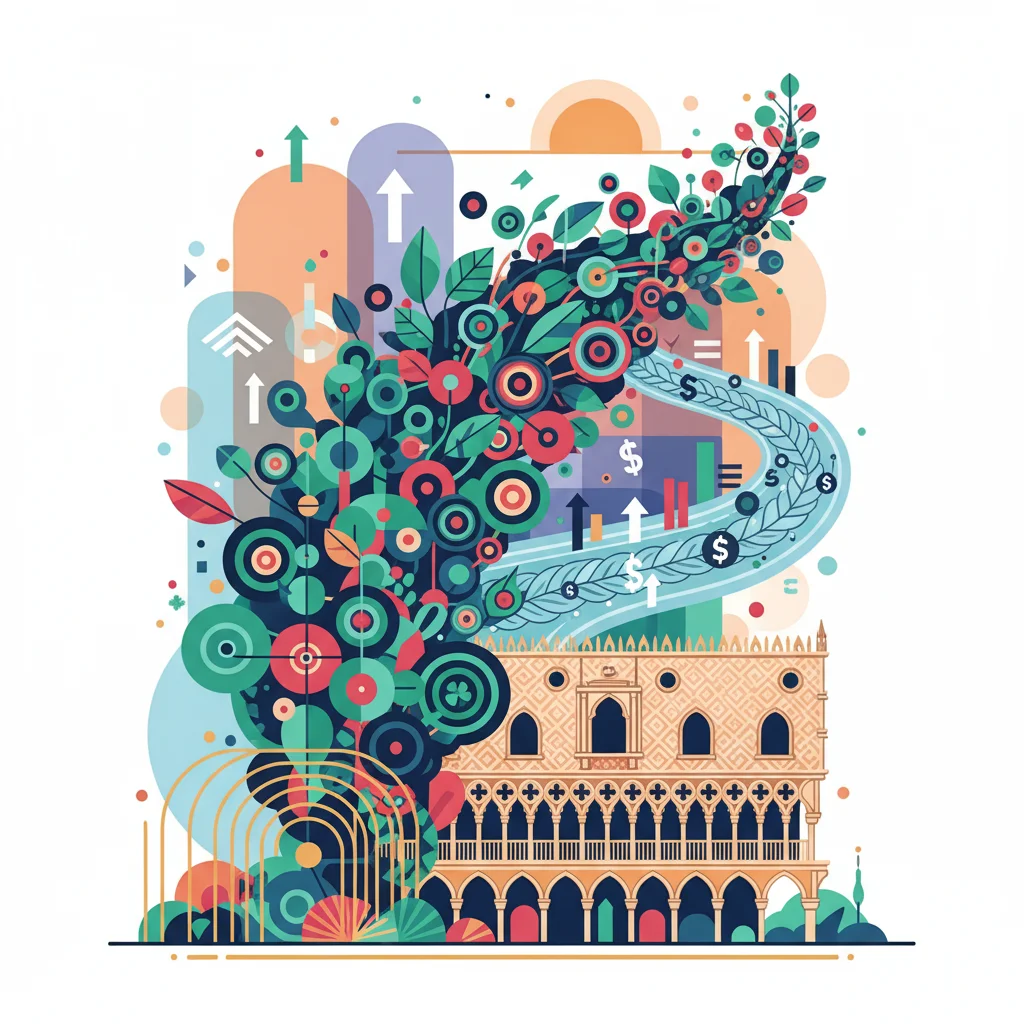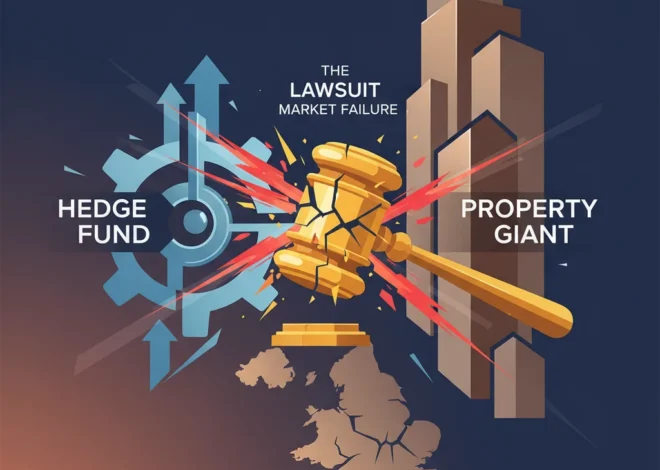
The Palazzo Principle: What a Venetian Garden Teaches Us About Modern Finance and Long-Term Value
In the heart of Venice, where canals replace roads and history whispers from every stone, lies a space that serves as an unlikely blueprint for modern financial strategy. It’s not a bustling stock exchange or a sleek fintech incubator, but a garden. Specifically, the garden of Palazzo Brandolini, home to Marcantonio Brandolini d’Abba, an artist and the chief executive of the prestigious glassware brand Laguna~B. At first glance, this serene oasis seems a world away from the relentless pace of the global economy. Yet, the principles that govern this centuries-old sanctuary offer profound lessons for today’s investors, business leaders, and financial innovators.
The palazzo’s garden, which Brandolini d’Abba uses as an “outdoor design studio,” is more than just a source of artistic inspiration. It is a living metaphor for building enduring value, cultivating a competitive moat, and fostering sustainable innovation—concepts that are the very bedrock of successful long-term investing. In an era dominated by high-frequency trading, fleeting digital trends, and the venture-backed race for quarterly growth, the wisdom of the palazzo provides a powerful counter-narrative: true wealth is cultivated, not just captured.
The Fortress of Value: The Palazzo as an Economic Moat
In the world of finance, a company’s “economic moat” is its ability to maintain competitive advantages over its rivals, protecting its long-term profits and market share. Warren Buffett popularized the term, and it remains a cornerstone of value investing. The Palazzo Brandolini is the physical embodiment of a deep, unbreachable moat. Situated on the Grand Canal, its history, location, and architectural significance create a barrier to entry that is, quite literally, impossible to replicate. No amount of capital can build another 16th-century palazzo in that exact spot.
This illustrates a critical lesson for investors navigating the modern stock market. While many are drawn to disruptive tech companies with promising, yet unproven, business models, enduring value often resides in businesses with deep, structural moats. These can include:
- Intangible Assets: A brand name built over generations, like Laguna~B, possesses a level of trust and prestige that a startup cannot buy. This is the brand’s “palazzo.”
- Network Effects: A platform whose value increases as more users join it, creating a fortress of user loyalty.
- High Switching Costs: Systems so embedded in a customer’s operations (think legacy banking software) that changing providers is prohibitively expensive and complex.
The palazzo’s garden, nurtured over centuries, is a testament to the power of patient capital and the compounding effect of time. It reminds us that the most resilient assets in any portfolio or business are often those cultivated with a long-term vision, insulated from the cyclical storms of the market. The Capital Conundrum: Do Left-Leaning Economies Stifle Investor Confidence?
The Garden as an R&D Lab: Fostering Organic Innovation
Brandolini d’Abba draws direct inspiration from his garden’s flora for his vibrant glassware designs. This space is not a static monument but a dynamic engine of creativity. This model of an “outdoor design studio” presents a compelling alternative to the high-burn, pressure-cooker R&D labs common in the financial technology sector. While fintech aims for disruption through code, the garden fosters innovation through observation, adaptation, and organic growth.
This approach highlights a different kind of ROI—Return on Inspiration. For a business like Laguna~B, the garden is a perpetual source of new ideas, ensuring the brand remains relevant and creatively vibrant without chasing fleeting trends. This is a powerful lesson in sustainable innovation. A company that builds a self-sustaining “garden” of creativity—be it through a strong corporate culture, investment in employee education, or cross-disciplinary collaboration—is less likely to suffer from the creative droughts that plague companies focused solely on iterative, market-driven updates. The inspiration is a core asset, not just a line item in an R&D budget (source).
Craftsmanship vs. Code: A New Perspective on Value Creation
Each piece of Laguna~B glassware is a unique, handcrafted object. In the language of modern technology, it is a non-fungible asset. This provides a fascinating lens through which to view the concepts underpinning blockchain technology and NFTs, which use digital ledgers to verify the uniqueness and ownership of an asset. While an NFT is a line of code, a Laguna~B glass is a tangible object imbued with history, skill, and artistic intent. Both, however, derive their value from verifiable scarcity and authenticity.
This contrast brings to light a fundamental tension in the modern economy: the value of scalable, reproducible assets (like software or a fintech app) versus the value of unique, artisanal assets (like a piece of art or a luxury good). The following table explores these two models of value creation:
| Principle | The Palazzo Model (Artisanal Value) | The Fintech Unicorn Model (Scalable Value) |
|---|---|---|
| Value Driver | Scarcity, craftsmanship, brand heritage, provenance. | Network effects, user growth, market share, data monetization. |
| Growth Strategy | Organic, patient, focused on quality and reputation. | Aggressive, rapid scaling, often at the cost of short-term profitability. |
| Economic Moat | Deeply entrenched brand, unique IP, impossible-to-replicate history. | First-mover advantage, high switching costs, proprietary technology. |
| Risk Profile | Vulnerable to changing tastes and trends; limited scalability. | High burn rate, regulatory risk, intense competition, market saturation. |
| Financial Parallel | Blue-chip stocks, real estate, art investing. | Venture capital, growth stocks, cryptocurrency trading. |
Neither model is inherently superior; a robust economy and a diversified investment portfolio require both. However, the Palazzo Model serves as a vital reminder that in a world rushing toward digital abstraction, tangible, differentiated quality remains a powerful and enduring source of economic value. High Stakes at the High Court: The Trillion-Dollar Question of Presidential Tariff Power
The Economics of Enduring Beauty and Legacy
Why does a centuries-old palazzo on the Grand Canal command a value that defies simple financial modeling? The answer lies in the economics of aesthetics, history, and legacy. These are not “soft” metrics; they are powerful economic forces that create a pricing power and asset resilience that few modern corporations can match. As the chief executive of Laguna~B, Marcantonio Brandolini d’Abba is not just selling glassware; he is selling a piece of the Venetian story (source). This narrative is a priceless asset.
For investors and business leaders, the lesson is to look beyond the immediate P&L statement. Does the company have a compelling story? Is it a steward of a legacy or a creator of a new one? In the financial services industry, for example, older institutions in banking often leverage their centuries-long history as a mark of stability and trust, a clear competitive advantage against newer, more agile fintech challengers.
This “legacy premium” is a potent force across markets. It explains why a vintage watch can appreciate in value, why certain luxury brands can command extraordinary prices, and why investors will pay a premium for stock in a company with a long, stable history of dividend payments. It is the financial manifestation of trust built over time.
Conclusion: Cultivating Your Own Palazzo
The garden of Palazzo Brandolini is more than a beautiful space; it is a masterclass in value creation. It teaches us that the most resilient investments and businesses are like well-tended gardens—they require patience, a deep understanding of the environment, a commitment to organic growth, and a protective moat to shield them from external threats.
For the modern financial professional, the “Palazzo Principle” is a call to integrate a long-term, qualitative perspective into a world of quantitative analysis. It encourages us to ask different questions: What is this company’s “garden” for innovation? How deep and enduring is its “moat”? Is it building a legacy that will appreciate over centuries, or is it merely chasing the fleeting returns of a single season? In the volatile currents of the global market, building your own palazzo—an unassailable fortress of value, heritage, and sustainable innovation—is the ultimate strategy for enduring success.


